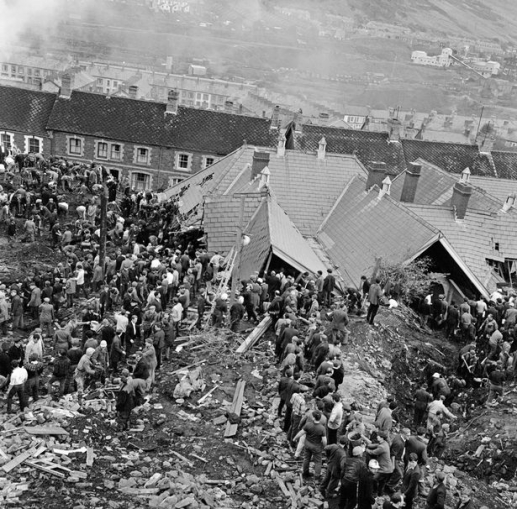50th Anniversary of tragedy at Aberfan - A disaster that could and should have been prevented
On Friday 21 October 1966, a terrible disaster befell the coal mining village of Aberfan in South Wales. On that day a catastrophic collapse of a colliery spoil tip killed 116 children and 28 adults. For decades leading up to 1966 excavated mining debris from the National Coal Board's Merthyr Vale Colliery had been deposited on the side of Mynydd Merthyr, directly above Aberfan. Early on the morning of 21 October, after a number of days of heavy rain, the subsidence began. At about 9.15 am more than 150,000 cubic metres (5,300,000 cu ft) of saturated debris flowed downhill at high speed. Destroying in its path a farm, a number of terraced houses and smashing into the side of Pantglas Junior School and part of the separate senior school. The thick black mud and rubble demolished walls and filled the classrooms up to a depth of about 33 ft (10 metres).
Desperate parents rushed to the scene, many digging through the rubble with their bare hands, trying to rescue the buried children. Police from Merthyr Tydfil arrived on the site, volunteers rushed to the village including miners from local collieries and other pits across South Wales. Conditions remained treacherous with a large amount of water and mud still flowing down the slope. Some children were pulled out alive in the first hour, but no survivors were found after 11 am. Emergency services workers and volunteers continued their rescue efforts but it was nearly a week before all the bodies were recovered. The final death toll was 144, including 116 children between the ages of 7 and 10. Most of the victims were interred at Bryntaf Cemetery in Aberfan in a funeral held on 27 October 1966, attended by more than 2,000 people.
A subsequent tribunal to inquire into the causes of and circumstances of the tragedy was held. It placed blame for the disaster upon the National Coal Board stating in its conclusion: 'The Aberfan disaster is a terrifying tale of bungling ineptitude by men charged with tasks for which they were totally unfitted'. There had been warnings about the danger of the tips above Aberfan prior to the tragedy. The loose rock and mining spoil had been piled over a layer of porous sandstone that contained many underground springs. Local authorities had already raised concerns about the tip pointing out that it posed a risk to the village primary school. The NCB's area management did not adequately act upon these concerns.
The chairman of the National Coal Board (NCB) at the time was Alfred Lord Robens. When he eventually arrived in Aberfan on the evening of the day after the disaster, he told a TV reporter that the slide had been due to 'natural unknown springs' beneath the tip and that nothing could have been done to prevent the slide. This was not true, the springs had been known about and were marked on maps of the area. Yet the NCB had continued to tip on top of these springs. The potential danger posed by the tip to Pantglas school had also been previously acknowledged. There had also been previous incidents of tip instability in South Wales that would have given clear information on the very real dangers posed. The Aberfan inquiry of 1967 stated: ‘Our strong and unanimous conclusion is that the Aberfan disaster could and should have been prevented’.
Many tributes have taken place or are planned throughout Wales and in other parts of the world around the anniversary of the Aberfan disaster. It has been described as Aberfan’s 'lost generation' remembered 50 years on. Leaving behind many whose lives have been permanently scarred by the experience of that tragic day on 21 October 1966.

- Mair Williams's blog
- Log in to post comments





